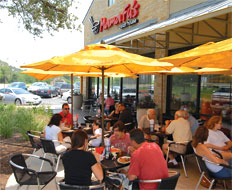The restaurant world can often seem like a battle between David and Goliath wherein small, independent restaurants are battling the giant corporations for share of stomach. But what if those two camps weren’t mutually exclusive?
That’s the scenario playing out in some restaurant companies. Franchisees get their feet wet with big established brands and use the profits and knowledge gleaned from the giants to start independent concepts.
Greg Schulson, CEO of Chicago-based Lunan Corporation, says years of experience with Arby’s prepared him to create and build Burrito Beach Mexican Grill within the company’s portfolio.
“[Our Arby’s franchise] is a family business started by my father, who was one of the original franchisees of Arby’s in the 1960s,” Schulson says. “Burrito Beach was a passion project.”
Schulson knows the portfolio mix works because Burrito Beach has been around for two decades and grown to six locations. Lunan Corporation and its subsidiaries and affiliates also own and operate more than 40 Arby’s restaurants.
“We have a very successful, growing, independent brand, and we continue to be excited about Arby’s,” Schulson says.
He says the difference between operating an established major brand and creating an independent brand is simple. With the independent brand, founders must push it forward on their own each day, whereas the robust system of a national brand provides all the necessary tools to execute the business.
Another restaurant company that has mixed a handful of independents with a big national brand is Aurify Brands. The New York City–based company’s businesses include Five Guys, along with independent fast casual 2.0s Melt Shop, Make Sandwich, The Little Beet, and Fields Good Chicken.
Partners Andy Stern and John Rigos got started in the restaurant business as Five Points Partners in 2003 by building or acquiring multiunit national franchise networks with brands like Dunkin’ Donuts, Baskin-Robbins, and Subway. In 2006, they bought the rights to develop Five Guys in New York City and changed their company’s name to Aurify.
Stern and Rigos successfully grew Five Guys’ New York network, but they wanted to go further both in terms of variety and geography. They were also inspired by a tech-focused business incubator called Idealab.
“The problem with franchising is you don’t own anything,” Rigos says. “We wanted to couple the Idealab experience with what we learned from the franchising world so we could own the intellectual property of a business.”
The cash flow from operating multiple Five Guys locations was reliable and growing, he says, and that has helped support the infrastructure needed to build Aurify’s other brands. “With Five Guys, they give you the playbook,” he says. “With each new brand, we have to figure everything out.”
Lynette McKee, CEO of the franchising and development strategic advisory firm McKeeCo Services, says creating an independent brand means creating a marketing program, a training program and operating systems, as well as calculating all costs. As a franchisee of one major national brand, operators get the instruction manual. A multi-brand franchisee for more than one major concept gets multiple manuals. To start an independent concept, the founders have to write the manual.
“You have to find the real estate and design everything from the menu to the kitchen,” McKee says. “It doesn’t come to you all set up like it does when you sign on as a franchisee for a big brand.”
She says franchisees wanting to start a new concept have to make sure bringing it to life doesn’t harm the business already in operation. The first step is to carefully reread the contract they entered into with their franchisor to ensure the new concept won’t be a conflict of interest. Most brands include non-compete language in their standard franchise agreements.
“You can’t ignore the one that is creating the cash flow to fund the new one,” McKee says. “If 80 percent of your focus is on creating this new brand and you falter and the franchisor is contacting you with issues, you could have an implosion.”
She says the financial costs of operating an established brand are known, but there’s no ceiling with a new brand. That said, McKee adds that when franchisees create their own new concepts, it’s good for the industry and it can be lucrative for the creator.
Franchising with tried-and-true national brands provides a solid education for operators who want to launch their own concepts.
The bottom line seems to be that if a franchisee is content to work within the parameters of a big brand while also possessing the creativity and knowledge to start up an independent concept, a mixed portfolio like those of Aurify or Lunan could be the best of both worlds. But it doesn’t work for everyone.
McKee once worked with a man who had started a few brands and then became a franchisee for a national chain. Eventually he switched back to solely being an independent operator.
“He said it was stifling to have to operate within a model,” McKee says. “It didn’t fit who he was as a creator of brands, so he sold out and went back to being a small operating partner.”
This story originally appeared in QSR’s March 2017 issue with the title “The Best of Both Worlds.”











